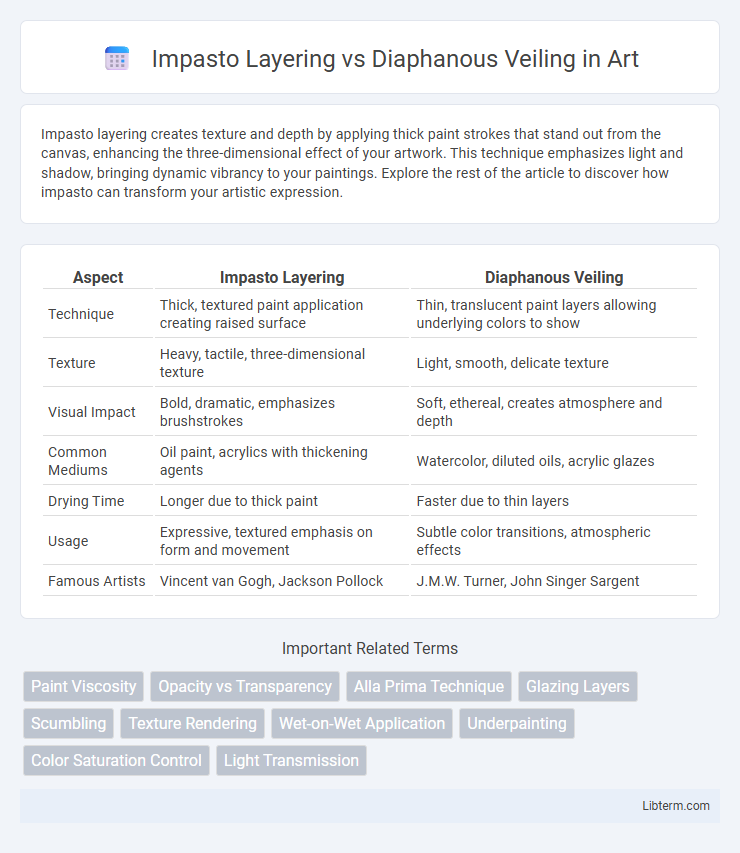Impasto layering creates texture and depth by applying thick paint strokes that stand out from the canvas, enhancing the three-dimensional effect of your artwork. This technique emphasizes light and shadow, bringing dynamic vibrancy to your paintings. Explore the rest of the article to discover how impasto can transform your artistic expression.
Table of Comparison
| Aspect | Impasto Layering | Diaphanous Veiling |
|---|---|---|
| Technique | Thick, textured paint application creating raised surface | Thin, translucent paint layers allowing underlying colors to show |
| Texture | Heavy, tactile, three-dimensional texture | Light, smooth, delicate texture |
| Visual Impact | Bold, dramatic, emphasizes brushstrokes | Soft, ethereal, creates atmosphere and depth |
| Common Mediums | Oil paint, acrylics with thickening agents | Watercolor, diluted oils, acrylic glazes |
| Drying Time | Longer due to thick paint | Faster due to thin layers |
| Usage | Expressive, textured emphasis on form and movement | Subtle color transitions, atmospheric effects |
| Famous Artists | Vincent van Gogh, Jackson Pollock | J.M.W. Turner, John Singer Sargent |
Understanding Impasto Layering: A Textural Approach
Impasto layering involves applying thick, textured paint strokes that create a three-dimensional surface, enhancing the tactile quality of the artwork. This technique emphasizes bold brushwork and vivid pigment application to build depth and dynamic visual interest. By contrasting with diaphanous veiling, which uses thin, translucent layers for subtle effects, impasto prioritizes robust texture and physicality in painting.
Diaphanous Veiling: The Art of Subtle Transparency
Diaphanous veiling in painting involves applying thin, translucent layers of paint that create a luminous effect, allowing underlying textures and colors to subtly emerge, enhancing depth and complexity. This technique contrasts with impasto layering, which uses thick, textured paint applications to build surface dimension and physical presence. Diaphanous veiling emphasizes gentle transparency and light interplay, producing ethereal visual experiences that evoke softness and atmospheric nuance.
Historical Perspectives: Evolution of Both Techniques
Impasto layering, characterized by thick, textured paint applications, gained prominence during the Renaissance with artists like Titian, evolving through Baroque masters such as Rembrandt who emphasized dramatic light and texture. Diaphanous veiling, involving thin, semi-transparent paint layers, developed concurrently in the Venetian school and flourished in Rococo works by artists like Jean-Honore Fragonard, highlighting delicate light effects and soft transitions. Both techniques reflect historical shifts in artistic priorities, from tactile surface drama to ethereal luminescence, shaping Western painting's expressive vocabulary from the 15th to 18th centuries.
Surface Effects and Tactile Qualities
Impasto layering creates pronounced surface textures with thick, raised paint applications that enhance tactile richness and invite physical interaction. Diaphanous veiling employs thin, translucent paint layers that produce smooth, delicate surfaces emphasizing subtle light diffusion and atmospheric depth. These contrasting techniques offer distinct sensory experiences, with impasto emphasizing sculptural texture and diaphanous veiling highlighting ethereal visual softness.
Techniques and Tools for Impasto Layering
Impasto layering involves applying thick, textured paint using palette knives or stiff-bristle brushes to create pronounced, three-dimensional effects that enhance light reflection and surface depth. Artists often use heavy-bodied acrylics or oil paints combined with mediums like molding paste or gel to increase paint viscosity and maintain structural integrity. This technique contrasts with diaphanous veiling, which employs thin, translucent layers for subtle color blending and luminosity.
Achieving Luminous Veils: Methods and Materials
Achieving luminous veils in painting involves contrasting techniques such as impasto layering and diaphanous veiling, each utilizing distinct methods and materials. Impasto layering, characterized by thick applications of oil or acrylic paint, enhances texture and light reflection, creating vibrant, tactile surfaces, while diaphanous veiling employs thin, translucent glazes or washes using mediums like linseed oil or acrylic retarders to build delicate, glowing layers. Mastery of pigment concentration, drying times, and brushwork is essential to optimize luminosity and depth in both techniques, enabling artists to manipulate light for dynamic visual effects.
Color Dynamics: Opaque vs. Translucent Applications
Impasto layering creates vivid color dynamics through thick, opaque paint applications that enhance texture and light reflection, intensifying visual impact. Diaphanous veiling employs translucent glazes, allowing underlying colors to shimmer and blend softly, producing subtle luminosity and depth. These contrasting techniques manipulate opacity to influence color perception, with impasto's solid hues contrasting diaphanous veiling's ethereal transparencies.
Artistic Intention: Expressive vs. Ethereal Visuals
Impasto layering emphasizes thick, textured paint application to create bold, expressive visuals that convey emotion and movement through tangible surface depth. Diaphanous veiling utilizes thin, translucent layers to achieve ethereal effects, softening colors and forms for a luminous, delicate appearance. Artists choose impasto for intensity and dynamism, while diaphanous veiling supports subtlety and atmospheric lightness in their work.
Contemporary Uses in Modern Art
Impasto layering in contemporary art emphasizes texture and depth through thick, expressive applications of paint, creating dynamic surfaces that engage viewers on a tactile level. Diaphanous veiling, characterized by translucent, thin washes, introduces ethereal lightness and subtle color shifts, often used to evoke mood and atmosphere in modern compositions. Artists today exploit these contrasting techniques to balance bold materiality with delicate luminosity, enriching visual narratives in diverse media.
Choosing the Right Technique for Your Artistic Vision
Choosing between impasto layering and diaphanous veiling depends on the desired texture and depth in your artwork. Impasto layering creates bold, textured surfaces with thick applications of paint that capture dynamic light and shadow, ideal for expressive and tactile compositions. Diaphanous veiling employs translucent layers to build subtle color gradations and ethereal effects, perfect for conveying delicacy and atmospheric depth in your artistic vision.
Impasto Layering Infographic

 libterm.com
libterm.com